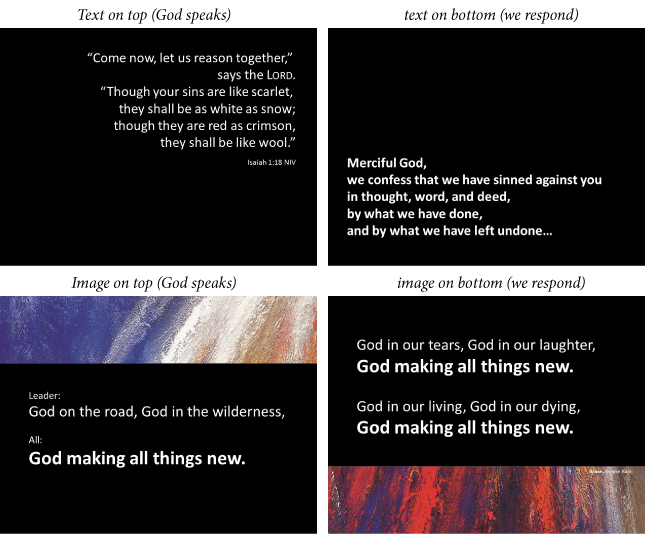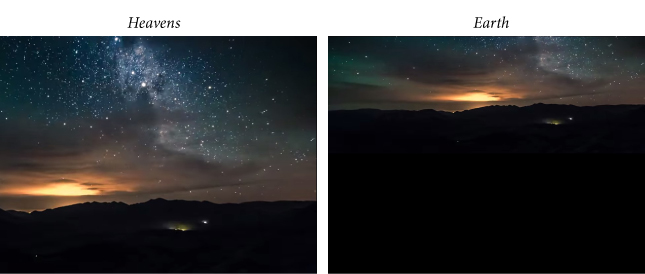Betsy Steele Halstead is an artist in oils, acrylics and woodcuts. She is also the program coordinator for grants and communications and the resource specialist for visual arts at the Calvin Institute of Christian Worship in Grand Rapids, Mich. In this edited conversation, she talks about how projected images in worship shape people’s understanding of what worship is and whom God welcomes to worship.
Worship leaders often describe worship as a dialogue between God and gathered people. How can screens and projected images help worshipers see themselves as part of this welcoming dialogue?
Projection plays many different roles in worship. It can have a decorative (beautifying), pastoral (healing) or prophetic role (challenging). It can also have a teaching role. It can visually communicate biblical or theological ideas, such as the idea that worship is a dialogue between God and gathered people.
The vertical line metaphorically displays our dialogue with God. We act this out in responsive prayers and songs. The horizontal line displays our dialogue with each other and the created world, something we act out in the passing of the peace.
These examples visualize vertical dialogue:

Images that focus more on “the heavens” or “the earth” also denote vertical dialogue. Ideally, over time, projected images show a balance between heaven and earth. The examples below show the difference between highlighting the top or bottom of an image.

These examples visualize horizontal dialogue throughout a service:

It’s important to remember we are talking about gathered people. Worship is more about we than me. This is extremely important to communicate visually. Too often we see projected images of only one person. But when you place this individual in a group, worshipers understand it as “We stand before God and I stand before God.” Our individuality is not lost in community. Abstract imagery helps communicate the idea that “I, we and all of creation stand before God.”
Consider replacing individual imagery with group or abstract imagery.

How might projected imagery make worshipers feel welcome or not included?
Projection can play an important role in making room for guests and communicating the diversity of God’s people. All people will feel more welcome if they see diversity in your photo choices for pre-service church ministry announcements. I encourage worship teams to review images they have used over the last year, just as you might do for songs and hymns. Check whether your selections reflect not only members of the congregation but also all generations, people of the local community and of the global community. If you use photos from local and global news sources to create visual prayers, then make sure you consciously display specific groups to show the breadth of whom God cares for.
If your church projects images of Christ, your choices over time should balance portraying a Christ for all times and places and for this time and place, a Christ for all people and this people, a Christ both divine and human. This takes thought, time and energy. But how we visually represent Christ is just as important as how we chose to verbalize or sing about who Christ is, was and will be.
What questions can worship and technology committees ask to discern whether their screen use is hospitable or not?
Besides what I just mentioned, there are many “little ways” to show hospitality in projected images. Ask your graphic design, tech and worship teams to specifically consider how they can be more pastorally sensitive to community needs. For projected slide design, avoid pixelated or distorted images. Use font sizes large enough to be seen from the back row. For projected prayers, break phrases in places that help congregations speak with one voice. Use correct punctuation and inclusive language. Cite copyrights to consistently honor artists, musicians and writers.
When you speak to groups about projection practices in worship, what questions do you hear most often?
People ask most often about where to find quality artwork. This is harder for visual art, because we don’t have something equivalent to Christian Copyright Licensing International CCLI. I always encourage people to take their own photos or just email artists such as Jan Richardson. You can check out Christians in the Visual Arts, Eyekons, Art Resources and Wikimedia Commons. Try iStock for a huge selection of backgrounds and images.
Because most churches don’t have a graphic designer putting their slides together, I get many questions about how I designed something. The simplest of screens—black background with white text—has design. It’s best to use just one or two fonts throughout and to stay consistent in vertical space (leading) between lines of type.
Which questions would you like to hear more often?
I would love to hear churches asking, “How can we expand our knowledge and use of biblical imagery, motifs and metaphors?” and “How can we better integrate what is on the screen with the surrounding environment of our church space?”
LEARN MORE
Explore resources from Calvin Institute of Christian Worship on images and screens in worship. Consider five things before you buy a projector and screen. See Canyon Reflection, a liturgical banner set that Betsy Steele Halstead created for the 2016 Calvin Symposium on Worship.
The photos above are free download stock images and work from artists Anneke Kaai, Kathy Hastings, Carol Aust, Jan Richardson and Julie Quinn.

